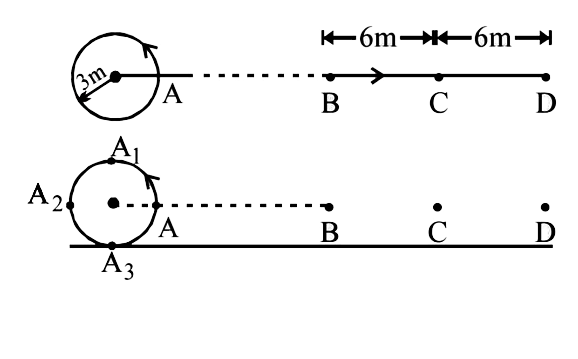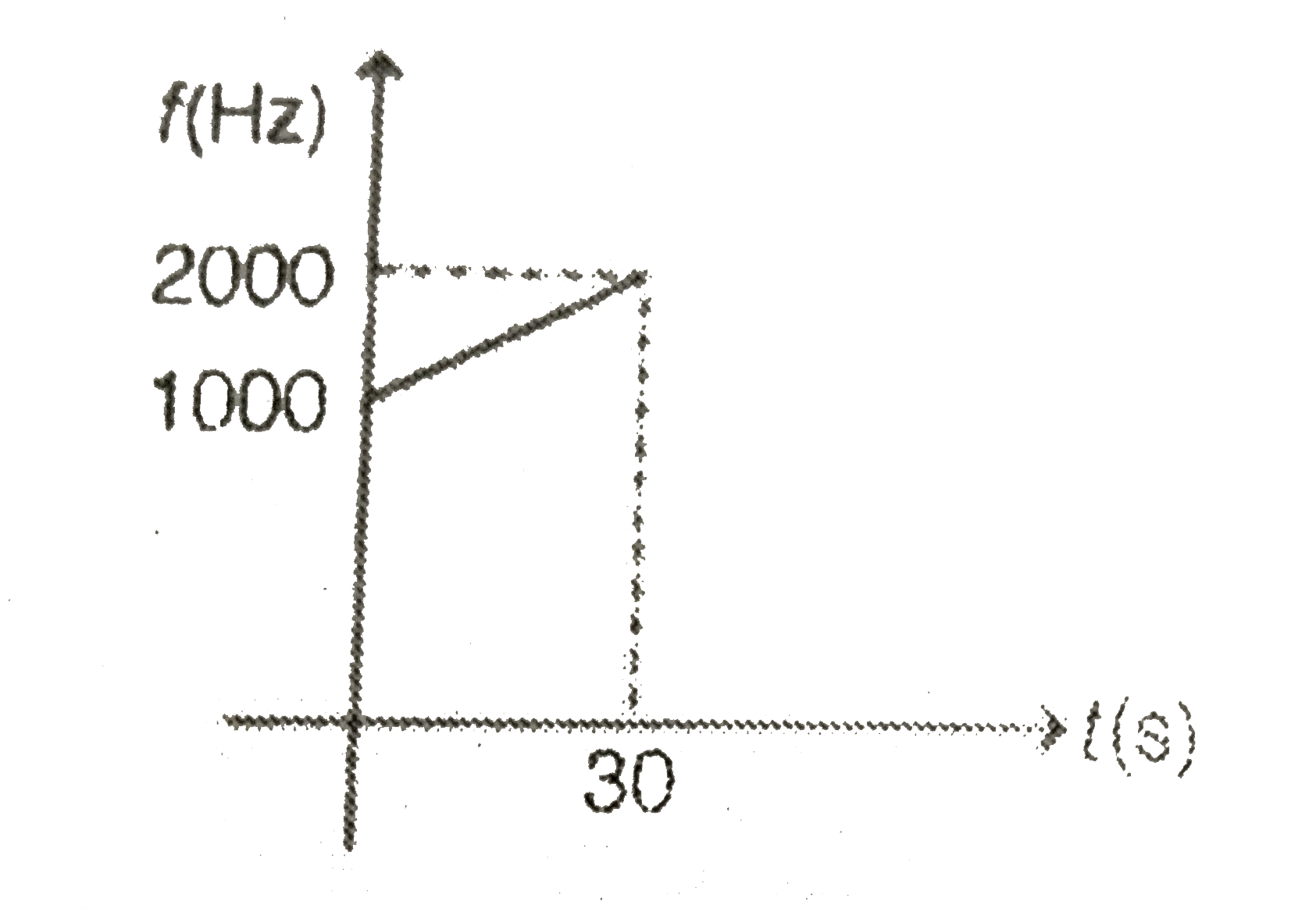A source of sound is moving along a circular orbit of radius 3m with an angular velocity of 10 red/s. A sound detector located far away from the source is executing linear simple harmonic motion along the line BD with amplitude BC = CD = 6m. The frequency of oscillation of the deterctor is (5/π) rev/sec. The source is at the point A when the detector is at the point B. If the source emits a continuous sound wave of frequency 340 Hz, find the maximum and the minimum frequencies recorded by the detector [velocity of sound =330 m/s].
![A source of sound is moving along a circular orbit of radius 3m with an angular velocity of 10 red/s. A sound detector located far away from the source is executing linear simple harmonic motion along the line BD with amplitude BC = CD = 6m. The frequency of oscillation of the deterctor is (5 //pi) rev/sec. The source is at the point A when the detector is at the point B. If the source emits a continuous sound wave of frequency 340 Hz, find the maximum and the minimum frequencies recorded by the detector [velocity of sound =330 m/s].](https://d10lpgp6xz60nq.cloudfront.net/physics_images/AKS_ELT_AI_PHY_XII_V02_C_C01_SLV_043_Q01.png)
Time period of circular motion T=(2π/ω)=(2π/10)
is same as that of SHM. i.e., T=(1/f)=(π/5, so both will complete one periodic motion in same time.
Futher more, source is moving on a circle, its speed vs=rω=3×10=30m/s and as detector is executing SHM,vD=ω√A2−y2=10√62−y2
i.e., (vD)max=60m/s when y = 0 i.e.,detector is at C.Now in the case of Doppler effect,fAp=f[v±vDv±vS]
So fAp will be maximum when both move towards each other. fmax=f[v+vDv−vS] with vD= max i.e., the source is at M and detector at C and moving towards B, so
fmax=340[330+6330−30]=442Hz
Similarly fAp will be minimum when both are moving away from each other, i.e.,fmax=f[v−vDv+vS] with vD= max i.e., the source is at N and detector at C but moving towards D,so
fmin=340[330−60330+30]=255Hz
Topper's Solved these Questions
- WAVE MOTION AND SOUNDBOOK - AAKASH SERIESCHAPTER - WAVE MOTION AND SOUNDEXERCISE - EXERCISE (LONG ANSWER QUESTIONS)
1 Videos
- WAVE MOTION AND SOUNDBOOK - AAKASH SERIESCHAPTER - WAVE MOTION AND SOUNDEXERCISE - EXERCISE (VERY SHORT ANSWER QUESTIONS)
25 Videos
- WAVE MOTIONBOOK - AAKASH SERIESCHAPTER - WAVE MOTIONEXERCISE - PRACTICE SHEET ADVANCED (INTEGER TYPE QUESTIONS)
10 Videos
- WAVE OPTICSBOOK - AAKASH SERIESCHAPTER - WAVE OPTICSEXERCISE - PROBLEMS (LEVEL - II)
20 Videos
Similar Questions
A source of sound is moving along a circular orbit of radius 3meter with an angular velocity of 10rad/s. A sound detector located far away from the source is executing linear simple harmonic motion along the line BD with an amplitude BC=CD=6meters. The frequency of oscillation of the detector is 5π per second. The source is at the point A when the detector is at the point B. If the source emits a continuous sound wave of frequency 340Hz, Find the maximum and the minimum frequencies recorded by the detector.

View SolutionA source of sound is moving along a circular orbit of radius 3meter with an angular velocity of 10rad/s. A sound detector located far away from the source is executing linear simple harmonic motion along the line BD with an amplitude BC=CD=6meters. the frequency of oscillation of the detector is 5π per second. the source is at the point A when the detector is at the point B. if the source emits a continous sound wave of frequency 340Hz, find the maximum and the mnimum frequencies recorded by the detector.

View Solution
Knowledge Check
A detector is released from rest over a source of sound of frequency f0=103Hz. The frequency observed by the detector at time t is plotted in the graph. The speed of sound in air is (g=10m/s2)
 A330m/sB350 m/sC300 m/sD310 m/s
A330m/sB350 m/sC300 m/sD310 m/s
A source of sound is moving along a circular orbit of radius 3 m with an angular velocity of 10 rad/s. A sound detector located far away from the source is executing linear S.H.M. along the line BD (see Fig. 14.4.13) with an amplitude BC = CD=6m. The frequency of oscillation of the detector is 5/π per second. The source is at the point BA when the detector is at the point B. If the source epiits a continuous sound wave of frequency 340 Hz, find the maximum and the minimum frequencies recorded by the detector.

View SolutionA source of sound emitting a frequency 660 Hz is moving counter-clockwise in a circular path of radius 2 metres with an angular velocity 15 rad/s. A recorder at a distance from the source is moving simple harmonically along a straight line with an amplitude 2 metres. The frequency of SHM is 152π per second. The arrangement is shown in figure. When the source is at point A the detector is at D. Find the maximum and minimum frequencies recorded. Velocity of sound in air at this temperature can be taken as 300 m/s

View SolutionA source of sound is moving away from an observer at rest with a velocity of 50ms−1 . If the frequency of sound is 200 Hz , find the apparent frequency observed by the observer. (Take velocity of sound = 300ms−1)
View SolutionA source and a detector move away from each other, each with a speed of 10 m/s with respect to ground with no wind. If the detector detects a frequency 1650 Hz of the sound coming from the source, what is the original frequency of the source? (speed of sound = 340 m/s
View SolutionA small source of sound oscillates in simple harmonic motion with an amplitude of 17 cm. A detector is placed along the line of motion of the source. The source emits a sound of frequency 800 Hz which travels at a speed of 340ms−1 If the width of the frequency band detected by the detector is 8 Hz, find the time period of the source.
View SolutionA source of sound emitting a 1200 Hz note travels along a straight line at a speed of 170ms−1. A detector is placed at a distance of 200 m from the line of motion of the source. (a) Find the frequency of sound received by the detector at the instant when the source gets closest to it. (b) Find the distance between the source and the detector at the instant it detects the frequency 1200 Hz. Velocity of sound in air=340ms−1.
View SolutionA detector is released from rest over a source of sound of frequency f0=103Hz. The frequency observed by the detector at time t is plotted in the graph. The speed of sound in air is (g=10m/s2)

View Solution
